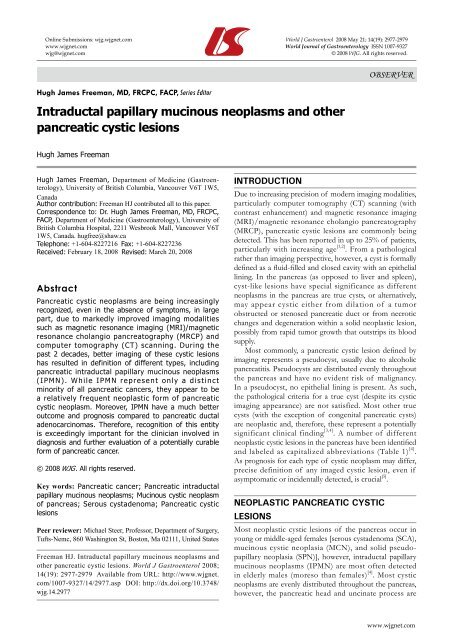Tradition or evidence based practice? - World Journal of ...
Tradition or evidence based practice? - World Journal of ...
Tradition or evidence based practice? - World Journal of ...
You also want an ePaper? Increase the reach of your titles
YUMPU automatically turns print PDFs into web optimized ePapers that Google loves.
Online Submissions: wjg.wjgnet.com W<strong>or</strong>ld J Gastroenterol 2008 May 21; 14(19): 2977-2979<br />
www.wjgnet.com W<strong>or</strong>ld <strong>Journal</strong> <strong>of</strong> Gastroenterology ISSN 1007-9327<br />
wjg@wjgnet.com © 2008 WJG. All rights reserved.<br />
Hugh James Freeman, MD, FRCPC, FACP, Series Edit<strong>or</strong><br />
Intraductal papillary mucinous neoplasms and other<br />
pancreatic cystic lesions<br />
Hugh James Freeman<br />
Hugh James Freeman, Department <strong>of</strong> Medicine (Gastroenterology),<br />
University <strong>of</strong> British Columbia, Vancouver V6T 1W5,<br />
Canada<br />
Auth<strong>or</strong> contribution: Freeman HJ contributed all to this paper.<br />
C<strong>or</strong>respondence to: Dr. Hugh James Freeman, MD, FRCPC,<br />
FACP, Department <strong>of</strong> Medicine (Gastroenterology), University <strong>of</strong><br />
British Columbia Hospital, 2211 Wesbrook Mall, Vancouver V6T<br />
1W5, Canada. hugfree@shaw.ca<br />
Telephone: +1-604-8227216 Fax: +1-604-8227236<br />
Received: February 18, 2008 Revised: March 20, 2008<br />
Abstract<br />
Pancreatic cystic neoplasms are being increasingly<br />
recognized, even in the absence <strong>of</strong> symptoms, in large<br />
part, due to markedly improved imaging modalities<br />
such as magnetic resonance imaging (MRI)/magnetic<br />
resonance cholangio pancreatography (MRCP) and<br />
computer tomography (CT) scanning. During the<br />
past 2 decades, better imaging <strong>of</strong> these cystic lesions<br />
has resulted in definition <strong>of</strong> different types, including<br />
pancreatic intraductal papillary mucinous neoplasms<br />
( I P M N ) . W h i l e I P M N represent o n l y a d i s t i n c t<br />
min<strong>or</strong>ity <strong>of</strong> all pancreatic cancers, they appear to be<br />
a relatively frequent neoplastic f<strong>or</strong>m <strong>of</strong> pancreatic<br />
cystic neoplasm. M<strong>or</strong>eover, IPMN have a much better<br />
outcome and prognosis compared to pancreatic ductal<br />
adenocarcinomas. Theref<strong>or</strong>e, recognition <strong>of</strong> this entity<br />
is exceedingly imp<strong>or</strong>tant f<strong>or</strong> the clinician involved in<br />
diagnosis and further evaluation <strong>of</strong> a potentially curable<br />
f<strong>or</strong>m <strong>of</strong> pancreatic cancer.<br />
© 2008 WJG . All rights reserved.<br />
Key w<strong>or</strong>ds: Pancreatic cancer; Pancreatic intraductal<br />
papillary mucinous neoplasms; Mucinous cystic neoplasm<br />
<strong>of</strong> pancreas; Serous cystadenoma; Pancreatic cystic<br />
lesions<br />
Peer reviewer: Michael Steer, Pr<strong>of</strong>ess<strong>or</strong>, Department <strong>of</strong> Surgery,<br />
Tufts-Nemc, 860 Washington St, Boston, Ma 02111, United States<br />
Freeman HJ. Intraductal papillary mucinous neoplasms and<br />
other pancreatic cystic lesions. W<strong>or</strong>ld J Gastroenterol 2008;<br />
14(19): 2977-2979 Available from URL: http://www.wjgnet.<br />
com/1007-9327/14/2977.asp DOI: http://dx.doi.<strong>or</strong>g/10.3748/<br />
wjg.14.2977<br />
INTRODUCTION<br />
OBSERVER<br />
Due to increasing precision <strong>of</strong> modern imaging modalities,<br />
particularly computer tomography (CT) scanning (with<br />
contrast enhancement) and magnetic resonance imaging<br />
(MRI)/magnetic resonance cholangio pancreatography<br />
(MRCP), pancreatic cystic lesions are commonly being<br />
detected. This has been rep<strong>or</strong>ted in up to 25% <strong>of</strong> patients,<br />
particularly with increasing age [1,2] . From a pathological<br />
rather than imaging perspective, however, a cyst is f<strong>or</strong>mally<br />
defined as a fluid-filled and closed cavity with an epithelial<br />
lining. In the pancreas (as opposed to liver and spleen),<br />
cyst-like lesions have special significance as different<br />
neoplasms in the pancreas are true cysts, <strong>or</strong> alternatively,<br />
may appear cystic either from dilation <strong>of</strong> a tum<strong>or</strong><br />
obstructed <strong>or</strong> stenosed pancreatic duct <strong>or</strong> from necrotic<br />
changes and degeneration within a solid neoplastic lesion,<br />
possibly from rapid tum<strong>or</strong> growth that outstrips its blood<br />
supply.<br />
Most commonly, a pancreatic cystic lesion defined by<br />
imaging represents a pseudocyst, usually due to alcoholic<br />
pancreatitis. Pseudocysts are distributed evenly throughout<br />
the pancreas and have no evident risk <strong>of</strong> malignancy.<br />
In a pseudocyst, no epithelial lining is present. As such,<br />
the pathological criteria f<strong>or</strong> a true cyst (despite its cystic<br />
imaging appearance) are not satisfied. Most other true<br />
cysts (with the exception <strong>of</strong> congenital pancreatic cysts)<br />
are neoplastic and, theref<strong>or</strong>e, these represent a potentially<br />
significant clinical finding [3,4] . A number <strong>of</strong> different<br />
neoplastic cystic lesions in the pancreas have been identified<br />
and labeled as capitalized abbreviations (Table 1) [4] .<br />
As prognosis f<strong>or</strong> each type <strong>of</strong> cystic neoplasm may differ,<br />
precise definition <strong>of</strong> any imaged cystic lesion, even if<br />
asymptomatic <strong>or</strong> incidentally detected, is crucial [5] .<br />
NEOPLASTIC PANCREATIC CYSTIC<br />
LESIONS<br />
Most neoplastic cystic lesions <strong>of</strong> the pancreas occur in<br />
young <strong>or</strong> middle-aged females [serous cystadenoma (SCA),<br />
mucinous cystic neoplasia (MCN), and solid pseudopapillary<br />
neoplasia (SPN)], however, intraductal papillary<br />
mucinous neoplasms (IPMN) are most <strong>of</strong>ten detected<br />
in elderly males (m<strong>or</strong>eso than females) [4] . Most cystic<br />
neoplasms are evenly distributed throughout the pancreas,<br />
however, the pancreatic head and uncinate process are<br />
www.wjgnet.com

















